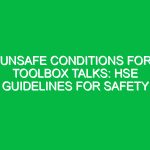Introduction
When emergencies strike, the ability to respond effectively can make a significant difference between life and death. This is especially true in workplaces where health, safety, and environmental (HSE) considerations are paramount. Understanding essential first aid steps not only equips individuals with the skills needed to handle unexpected situations but also fosters a culture of Safety and preparedness. In this article, we will delve into the critical first aid steps relevant to the HSE domain, providing you with the knowledge and confidence to act decisively in emergencies.
The Importance of First Aid in the HSE Context
First aid is the immediate assistance provided to a person suffering from an injury or illness. In the context of HSE, the significance of first aid cannot be overstated. Various workplaces, from construction sites to laboratories, expose employees to potential Hazards. A well-trained individual in first aid can mitigate risks, reduce recovery time, and sometimes save lives.
Consider a construction site where a worker falls from a height. Prompt first aid can stabilize the individual until emergency services arrive, potentially preventing further injury. This example illustrates the critical role first aid plays in ensuring Workplace Safety and compliance with health Regulations.
Key First Aid Steps Relevant to HSE
Understanding the fundamental first aid steps can prepare you for a range of scenarios. Here, we break down essential Procedures that are particularly relevant in the HSE context.
1. Assess the Situation
Before rushing to help, take a moment to assess the situation. Is the area safe for you to enter? Look for Hazards such as electrical wires, fire, or unstable structures. Your Safety is paramount, as you cannot help others if you become a victim yourself.
2. Call for Help
Once you’ve ensured the area is safe, call for professional help. Dial emergency services immediately, providing them with clear and concise information about the situation. If you’re in a workplace, notify your designated first aid officer or supervisor.
3. Check the Victim’s Condition
Approach the victim carefully and check their responsiveness. Ask if they can hear you or if they are okay. If they respond, reassure them and keep them calm. If they are unresponsive, you must check for breathing and a pulse.
4. Administer CPR if Necessary
If the victim is not breathing or lacks a pulse, begin cardiopulmonary resuscitation (CPR) immediately. The steps for CPR are as follows:
- Call for help or designate someone to do so.
- Place the person on their back on a firm surface.
- Perform chest compressions at a rate of 100-120 compressions per minute, allowing the chest to fully recoil between compressions.
- After every 30 compressions, provide 2 rescue breaths if trained to do so.
Remember, the earlier you start CPR, the better the chances of survival.
5. Control Bleeding
If the victim is bleeding, controlling the bleeding is crucial. Follow these steps:
- Apply direct pressure to the wound with a clean cloth or bandage.
- If bleeding continues, add more cloths without removing the original one.
- Elevate the injured area above the level of the heart if possible.
- Seek professional medical assistance for severe bleeding.
6. Treat for Shock
Shock can occur after severe injury or trauma. Signs of shock include pale skin, rapid pulse, and shallow breathing. To treat shock:
- Lay the person down and elevate their legs if there are no suspected injuries to the spine or legs.
- Keep them warm with a blanket.
- Do not give them food or drink.
7. Handle Burns and Scalds
Burns require specific first aid steps. For minor burns:
- Cool the burn under running water for at least 10 minutes.
- Cover the burn with a sterile, non-stick dressing.
- Avoid applying ice directly to the burn.
For severe burns, seek emergency medical assistance immediately.
8. Address Choking
Choking is a critical situation that requires quick action. If someone is choking and unable to breathe:
- Encourage them to cough if they can.
- If they cannot cough or speak, perform the Heimlich maneuver:
- Stand behind the person and wrap your arms around their waist.
- Make a fist and place it just above their navel.
- Grasp your fist with the other hand and thrust inward and upward until the object is expelled.
9. Recognize and Respond to Heart Attacks
Heart attacks may present with symptoms such as chest pain, shortness of breath, and sweating. If you suspect someone is having a heart attack:
- Call emergency services immediately.
- Have the person sit down and rest.
- If they have prescribed medication (like nitroglycerin), assist them in taking it.
10. Monitor the Victim
Throughout the emergency, keep monitoring the victim’s condition. Be prepared to perform CPR or other interventions as needed until help arrives. Your attentiveness can provide critical support in a high-stress situation.
Potential Hazards and Safety Considerations
While first aid is essential, it is equally important to be aware of the potential hazards that may arise during an emergency response.
Personal Safety
Always prioritize your safety. If the Environment poses risks, do not attempt to enter until it has been deemed safe. Use Personal Protective Equipment (PPE) if available, especially in hazardous environments.
Infection Control
Infection is a significant concern when providing first aid. Always use gloves when dealing with bodily fluids, and wash your hands thoroughly afterward. In case of exposure to blood, follow your organization’s protocols for reporting and managing potential infections.
Best Practices for First Aid Training in HSE
Training in first aid is not just beneficial; it is often a legal requirement in many workplaces. Here are some Best Practices to enhance first aid training:
Regular Training and Drills
Conduct regular first aid training sessions and drills to ensure that employees are confident in their skills. This practice not only helps reinforce knowledge but also prepares individuals to act swiftly in real emergencies.
Certification and Recertification
Encourage employees to pursue certification in first aid, CPR, and AED (Automated External Defibrillator) use. Many organizations, including the American Red Cross and St. John Ambulance, offer comprehensive training programs.
Creating an Emergency Response Plan
Develop a clear emergency response plan that outlines the roles and responsibilities of employees during an emergency. Ensure that this plan is easily accessible and regularly reviewed.
Regulations and Standards Governing First Aid Steps
In many jurisdictions, specific regulations govern the provision of first aid in the workplace. Knowing these regulations can help organizations maintain compliance and ensure safety.
Occupational Safety and Health Administration (OSHA) Standards
In the United States, osha sets forth regulations requiring employers to provide a safe workplace. This includes training employees in first aid and ensuring that appropriate supplies are readily available. Non-compliance can lead to legal repercussions and increased risks for employees.
International Standards
Globally, organizations such as the International Organization for Standardization (ISO) provide guidelines for Occupational Health and safety. These standards often emphasize the importance of first aid training and preparedness in the workplace.
Conclusion
Understanding and implementing essential first aid steps within the HSE context is crucial for enhancing Workplace Safety and preparedness. By being equipped with the knowledge to act in emergencies, individuals can contribute to a safer environment and potentially save lives. Regular training, adherence to regulations, and a culture of safety will empower employees to respond with confidence.
As you reflect on the importance of first aid in your workplace, consider taking proactive steps to enhance your knowledge and skills. The ability to respond effectively in emergencies not only Benefits individuals but also fosters a culture of care and responsibility within any organization. Embrace the challenge, and ensure that you are prepared to save lives with confidence.


